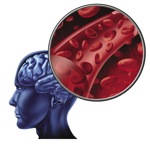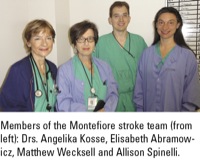Clinicians may have a new tool for predicting patient outcomes in the surgical intensive care unit. Developed at Massachusetts General Hospital as a simple grading scale to describe how well patients might tolerate being moved, the SICU Optimal Mobility Score (SOMS) has been found to be an independent predictor of length of hospitalization and mortality.
“Several highly ranked papers suggest that early mobilization of critically ill medical ICU [intensive care unit] patients is associated with improved outcome,” said Matthias Eikermann, MD, PhD, staff intensivist and anesthesiologist at Mass General and assistant professor of anesthesia at Harvard Medical School, both in Boston. “However, those data can’t necessarily be translated to the surgical ICU [SICU], because in the surgical ICU there are a host of factors that might affect the patient’s ability to ambulate.”
With that in mind, the researchers put together an interdisciplinary team of anesthesiologists, physical therapists, rehabilitation physicians and critical care clinicians to create the SOMS. The score rates the ability of patients to walk and move about freely, using an algorithm of simple but gradually more complex tasks that a patient must accomplish (Table).
| Table. The SICU Optimal Mobility Score |
| SOMS 0 | - Stable spine; no SCI
- ICP<20 mm Hg
- Not a moribund patient
|
| SOMS 1 | - Follows simple commands
- No open spinal drains, EVD, peritoneum, chest
- No femoral CVVH lines
|
| SOMS 2 | - Bilateral biceps strength 3/5 or more
- Sits without support
- No weight-bearing restrictions
|
| SOMS 3 | - Stands twice with minimal assistance
- Steps in place with minimal assistance
|
| SOMS 4 | |
| CVVH, continuous veno-venous hemofiltration; EVD, external ventricular drain; ICP, intracranial pressure; SCI, spinal cord injury; SICU, surgical intensive care unit; SOMS, SICU Optimal Mobility Score |
|
A SOMS of zero indicates that no mobilization for the sake of therapy should be attempted. Patients received a zero if they had high expected mortality during the first 24 hours of intensive care, an unstable head or spinal cord injury, those in whom any change in position led to profound respiratory or hemodynamic changes and those with elevated intracranial pressures.
Patients who could tolerate passive range-of-motion exercises while in bed received a SOMS of 1. Patients who were able to sit up in bed at an angle greater than 45 degrees, or who could sit in a chair, received a SOMS of 2. A SOMS of 3 described patients who could stand with or without assistance, and patients able to ambulate were characterized as a SOMS of 4.
To help determine the effectiveness of the scale, the investigators enrolled 113 consecutive SICU patients into the trial. On the morning after admission, two nurses independently predicted patients’ mobilization capacity using the SOMS; a third nurse recorded the patients’ achieved mobilization level at the end of each day. An expert team—including an intensivist, physiatrist, nursing specialist and physical therapist—also independently assessed patient mobilization capacity.
“We looked at validity and reliability, but more importantly, we tried to use this scale to predict patient outcome,” said Dr. Eikermann, whose group published its findings in the April issue of
Critical Care Medicine (2012;40:1122-1128).
Multivariate analysis revealed that the SOMS was an independent predictor of mortality (Figure;
P=0.001), and length of stay in the SICU and (
P=0.014) and hospital (
P=0.04).
“We observed a significant increased risk for reintubation and unplanned ICU admission, both of which are clinically meaningful findings,” Dr. Eikermann explained. “ICU admission is associated with a variety of adverse symptoms and diseases such as sleep disruption and deprivation, anxiety, and ICU-acquired psychosis. Mechanical ventilation, which also was associated with neuromuscular blocking agent treatment in our study, increases the risk for ventilator-associated pneumonia, which in turn is associated with long-lasting respiratory failure. Finally, our finding increased likelihood of ICU admission translates to increased costs of care.” At Mass General, he noted, the cost of care for a day in the ICU is 2.2-fold higher than the cost for a semiprivate bed on the floor.
In a follow-up analysis, the Mass General researchers compared the SOMS with the APACHE (Acute Physiology and Chronic Health Evaluation) score, a 12-item assessment that predicts mortality in ICU patients. “The APACHE score fell out of the logistic regression analysis, suggesting that the SOMS is at least as good as, if not better than, the APACHE score in predicting mortality in our patients,” Dr. Eikermann said.
Whereas the SOMS matched the APACHE in its ability to predict mortality, nurses reported that it was far easier to administer, Dr. Eikermann said. “I think the APACHE is very difficult and complicated to use,” he added. “I’m not saying we should not use the APACHE anymore, but one reason why the SOMS is so successful is because it’s so intuitive.”
Despite these promising results, the researchers recognized that more work is needed to determine the accuracy of the SOMS as an illness severity assessment and predictive tool. “The next step will be to see if this works in other units,” Dr. Eikermann explained. “Is it only a severity-of-illness instrument? Or if we kick patients out early by using this algorithm, are they actually getting higher mobilization levels, and does this in turn translate to an improved outcome? That’s where we are going.”
Charles B. Watson, MD, chair of anesthesia and deputy surgeon-in-chief at Bridgeport Hospital in Bridgeport, Conn., and an editorial board member of
Anesthesiology News, said dedicated staff time and cost requirements have delayed the implementation of systems like APACHE at many institutions. “I think we would all welcome a cheap, accurate way of demonstrating improvement and mortality that could justify staffing and intervention intensity,” Dr. Watson said.
The Mass General researchers are now conducting a six-center randomized controlled trial to see if goal-directed early mobilization can improve morbidity and mortality in SICU patients. Dr. Eikermann said other centers are welcome to participate in the project.




















